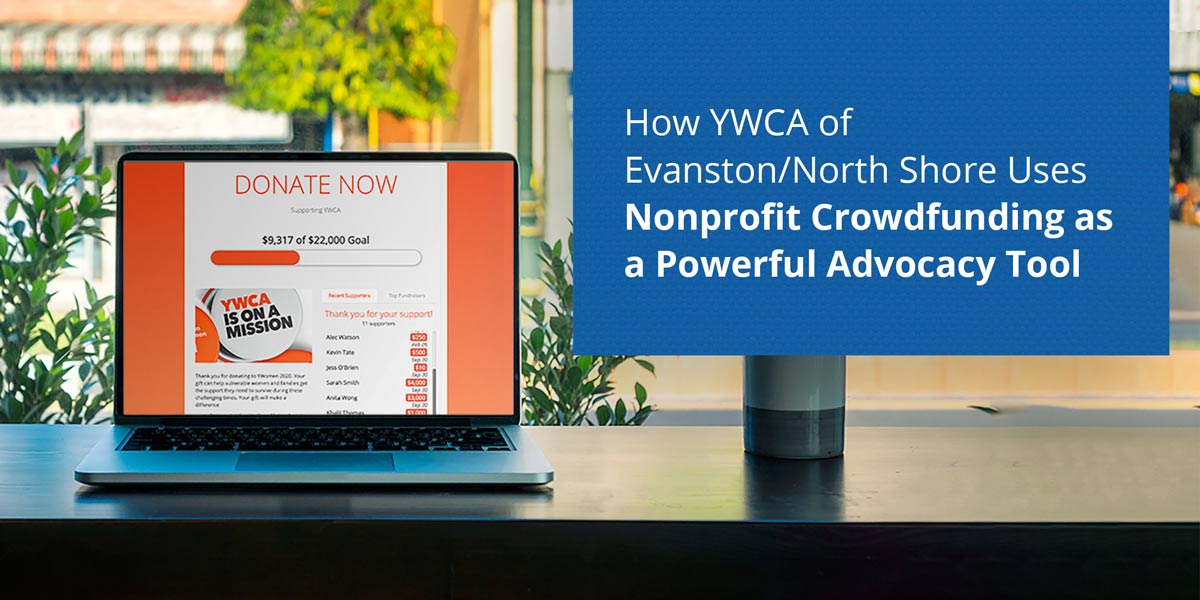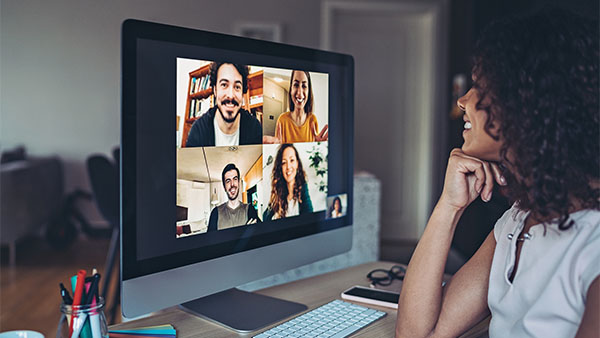Nonprofit Technology & Fundraising Blog
Subscribe to our mailing list
September 30, 2020 |

Nonprofit crowdfunding and advocacy go hand-in-hand. That’s because many people who care about your cause will readily engage with your nonprofit when you address hot topics they’re talking about online and at the dinner table.
We interviewed Robby Bardwell, Donor Stewardship Coordinator of YWCA of Evanston/North Shore to learn how his nonprofit turns these passionate individuals into advocates for his organization. Advocacy is a large part of YWCA’s work, as their organization serves as their local community’s go-to for education and resources for empowering women and eliminating racism. One of the major ways Robby and the YWCA development team have been supporting their advocacy efforts is through nonprofit crowdfunding.
Read on to learn about the power of nonprofit crowdfunding, along with how you can assemble a far-reaching advocacy campaign using nonprofit crowdfunding just like YWCA:

Nonprofit crowdfunding, or peer-to-peer fundraising, is a fundraising strategy that empowers a nonprofit’s supporters to fundraise on the organization’s behalf. Nonprofit crowdfunding tools enable an organization to set up a dedicated campaign page. From there, supporters can create their own “fundraiser” pages to share with their friends, family, and social networks. All donations collected by individual fundraisers are sent directly to the nonprofit.
Watch to see for yourself how it works:
When your fundraising campaign is limited to directing supporters to give to a stagnant donation page, the buck stops with them. With crowdfunding, you’re asking donors to create and share a fundraising page for your nonprofit, which has the potential to expand your donor base to all the like-minded individuals in their network.
Robby says, “It’s a great opportunity, in my opinion, to bring in new donors because peer-to-peer fundraising campaigns rely on other people to bring their friends and family into our organization as donors.”
Plus, you’re sure to garner more donations when:
Impact stories are powerful. They bring your incredible work to life and make your mission memorable. As Robby puts it, “Crowdfunding campaigns add a magic touch that you can’t get from a year-end appeal or traditional fundraising campaigns, because they add that personal touch of the supporter.”
Although fundraisers are the main drivers of a crowdfunding campaign’s success, Robby emphasizes that you should still take the time to develop your campaign’s overall message:
“You should encourage the person who is fundraising on your behalf to also add their own personal reason to the post before sharing to their social media. Their words are the message that people will react to. However, you should still have a well thought out ‘why’ when those prospective donors click the link to donate. Your ‘why’ also gets your active donors to give (or give again).”
Equipped with crowdfunding, your new fundraisers can support your organization regardless of their giving capacity, because setting up a fundraising page is entirely free for them. This way, you can build a community around your mission, without giving the impression that those who wish to join in must directly fund your campaign to be a part of it.
Because crowdfunding campaigns take place entirely online, people can participate from anywhere in the world. And at a time when social distancing is a must, this type of volunteer activity is becoming more popular than ever before.
Advocacy can be summarized in this short, yet powerful quote:
“There comes a point where we need to stop just pulling people out of the river. We need to go upstream and find out why they’re falling in.”
– Desmond Tutu
Where do nonprofits come in? Let’s use the example of homelessness in the following definitions:
Nonprofit advocacy is about educating key players, from community members to political leaders, and rallying support around a systemic issue to promote change.
By pairing the organic reach of a nonprofit crowdfunding fundraising strategy with the passion-fueled issues that motivate supporters to act, your organization can:
The emotions that news stories evoke compel people to take action. Your crowdfunding campaign grants them a solution they can take ownership of and a sense of control when they feel powerless.
Your crowdfunders will share their fundraising page with their networks, along with the facts and stats you want more people to know. Consider crowdfunders educators that can serve your nonprofit by teaching others just how critical your mission is to solving problems and progressing change.
In addition to disseminating crucial information to a larger audience, you’re adding a call to action. Once someone learns about the systemic issue your mission is addressing, they’ll be primed to move by giving to your organization.
For 501(c)(3)s, deciding whether to embark on an advocacy campaign can be quite nerve-wracking, considering that there are strict federal laws that prohibit these types of nonprofits from lobbying. But rest assured, you can support your service population this way without risk by following Robby’s suggestions:
YWCA offers training and workshops to educate their entire community about racial equity and women empowerment, and they expand on these learning opportunities with their annual summit.
A large part of the systemic changes your organization can progress live within the cultures of your local business communities. More and more, corporations are investing in “social good.” You can collaborate with them in their efforts to give back by contacting them about your sponsorship opportunities.
YWCA offers businesses a reciprocal relationship, offering discounts on equity workshops and providing equity assessments to address diversity and inclusion in a company’s culture on a mezzo level. This is a game changing addition to YWCA’s services, as they’ve expanded the community focus of their mission to impact private businesses.
For some of your supporters, the idea of inspiring change at a federal or even a state level can sound overwhelming, especially when those changes could take years to achieve.
Luckily, there’s a way to construct your donor journey to guide them through the donor and fundraiser milestones to the advocate status they want to achieve. Robby recommends providing supporters with specific actions they can take to reach the point of becoming an advocate.
YWCA promotes the transition from donor/fundraiser to advocate by:
By giving supporters a multitude of opportunities both large and small, they can choose actions that are most attainable for them and that give them a sense of accomplishment. And that positive feeling goes a long way. Robby shares, “I think as a nonprofit, you should really focus on those opportunities because they’re going to make your supporters feel good about their interaction with your organization and want to support you in other ways. With advocacy and with crowdfunding, the benefit is that they tend to retain donors.”

The key thing to remember when advocating for your community without lobbying is to simply not endorse a particular political party or candidate.
Robby explains, “There are ways that you can still show your support or condemnation for certain actions being taken on whatever issue you’re fighting for without endorsing any political party or any certain political candidate just by conveying how it affects the work that you’re trying to do.”
In your communications, you can rally supporters by explaining the impact of specific legislation on your service population and urging them to act by contacting their local government officials. Any political party can vote on a bill, making this call to action completely acceptable for a 501(c)(3).
What’s in a name? YWCA turns something as simple as a campaign name and turns it into an advocacy opportunity. During the month of October, in honor of Domestic Violence Awareness Month, YWCA hosts their Every Nine Seconds crowdfunding campaign. The name itself is a statistic, referring to the frequency at which women face abuse in the US. This strategy implores your audience to take a closer look at what your campaign is all about.

Part of the planning phase is determining who the key players of your campaign will be. Robby recommends, “If you’re doing an advocacy fundraising campaign, you’re going to want ‘boots-on-the-ground’ type-people, the doers who will canvas, as well as people with high spheres of influence like those on your board.”
To determine who those doers are, talk to your team. Get your development folks involved, the people in the field. Robby defines these individuals as, “the true connectors,” who see first-hand the day-to-day successes of the movers and shakers involved in your programs. If your role isn’t so closely tied to development, these staff members will be able to tell you who you need, including what impact stories will resonate most.
Bring in your board members.
Your board members tend to be the kind of C-suite and community organizer types of individuals who are able to leverage their position and influence to make corporate connections with major donors. Help them help you by pointing them in the direction of major donors.
Robby explains how the YWCA team was able to point out this kind of potential. “DonorPerfect played a really great role in utilizing not only our current donor base, but everyone who’s donated in the past. We could use wealth analysis and wealth screening to pinpoint those major donors that we could tap to fundraise such a large amount of money for our organization as well.”
Involve the people you’re advocating for.
YWCA educates that advocacy work should always involve those who are most impacted by the issue you’re addressing in your community. Talk directly with the people your nonprofit serves so that you can gain crucial insight into the problem and so that they can have a voice.
Send out an “SOS.”
Communicate with your supporters, across all of your programs, about the resources and talents that can lend to the success of your advocacy crowdfunding campaign. YWCA makes these connections effortlessly and organically by sharing updates and volunteer information about all of their programs in one, unified e-newsletter.
Regardless of how your supporters were introduced to your nonprofit, they stick around for a reason. And chances are, they want to help your cause in all the ways they can.
At YWCA, the development team does their best to include all of their supporters in every journey they embark on. Each department works together to keep record of every constituent who’s been involved with YWCA, whether or not they’ve given a gift. That way, Robby explains, “If somebody went to our equity workshop, and they learned about implicit bias, I can track that in our system. So then, when we’re |sending out appeal letters, we can even build out certain strategies and segmentations to appeal to them. Utilizing the Contacts tab in DonorPerfect, you can then tell the system, ‘show me all the people who came to an equity workshop between this point and this point’ because maybe they’re willing to donate now.”
In an advocacy crowdfunding campaign, Robby suggests using event data especially for solicitation. According to him, these supporters are more likely to get involved in campaigns that are advocacy-based.
Robby explains, “The more information and instructions you give to the supporters, the better. Some platforms allow for that, and some don’t because you can’t really do that on Facebook, but you can do that on DonorPerfect. Providing an instruction manual for participants is definitely something that you should build out in your strategy phase of a fundraising campaign.”
In a world that’s bombarded by misinformation, your organization is well-positioned to be a source of truth. Provide your crowdfunders with the facts they need to fundraise effectively. Statistics that support the urgency behind the problem your mission addresses can bolster the potency of an ask. With DonorPerfect Crowdfunding, you can host these critical details on the very campaign page where your crowdfunders will create their own fundraisers.
In addition to details about the campaign’s urgency and impact, you should also provide crowdfunders with everything they need to set up their own campaign through your crowdfunding tool.
The YWCA shares information and instructions in the form of a PDF on their website and via email to participating crowdfunders, which includes a template with best practices, data, and key messaging points.
Want to hear more of Robby’s crowdfunding tips? Check out his guest appearance in our webinar, Get Inspired: NPOs Share Their Crowdfunding Campaigns.
Follow us on social!